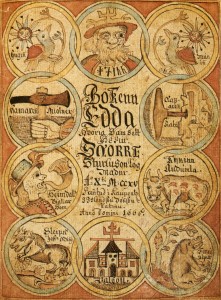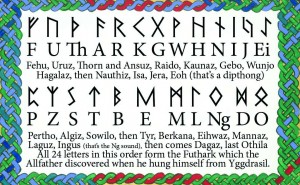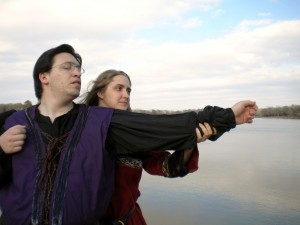Sundown: The Songs
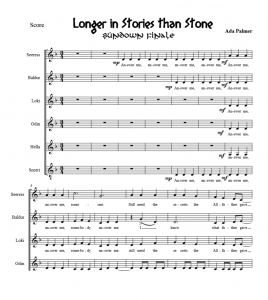 The pieces in the Sundown song cycle combine to tell a unified story, not just through their lyrics but through the recurring musical motifs and themes which recur and develop through the different pieces. The Sundown Play includes all 11 songs in sequence. Many of them are thickly layered, with multiple sets of lyrics at the same time, so listening and re-listening exposes more of the hidden textures of the pieces, and early pieces often contains hints or “whispers” of later melodies, just as Viking sagas contain prophecies of what must come.
The pieces in the Sundown song cycle combine to tell a unified story, not just through their lyrics but through the recurring musical motifs and themes which recur and develop through the different pieces. The Sundown Play includes all 11 songs in sequence. Many of them are thickly layered, with multiple sets of lyrics at the same time, so listening and re-listening exposes more of the hidden textures of the pieces, and early pieces often contains hints or “whispers” of later melodies, just as Viking sagas contain prophecies of what must come.
“Hearthfire”
- Setting out the themes of Sundown’s overarching story, “Hearthfire” is a tale told by a Viking lord, and introduces the harsh realities of survival in the frozen north, and the relationships Vikings had with the gods they thought of as walking among them. In the play, the story is being invented by Snorri Sturlson as a way to introduce the Viking cosmos to those unfamiliar. Hearthfire originally had three-part harmony, but in the play it is performed in five-part harmony.
“Ice and Fire”
- Most of what we know today about Norse mythology comes from two sources: the Poetic Edda, a collection of anonymous poetry, and the Prose Edda, a 13th-century collection of myths and folktales compiled by Snorri Sturluson (a real historical figure who twice won the highest elected office in Iceland before ultimately being betrayed and murdered by his kinsmen). This song relates the creation of the Norse Cosmos, told by Snorri and by his most important source, an ancient Seeress, one of the race of Jotuns or ice giants, who is the supposed speaker in the most important part of the Poetic Edda. As Snorri’s Edda contradicts the Poetic Edda, the two storytellers compete to forward their rival versions. Background voices representing the fundamental components of the Norse Cosmos, ice and fire, round the song out to four-part harmony.
“Gift of Life”
- “Gift of Life” relates the creation of the three sentient races, Elves, Dwarves and Men, created by Odin and his two brothers Hoenir and Lodur. It begins as a single voice, but expands over the course of the song, culminating in six-part harmony.
- The Viking alphabet, called the “Futhark” after its opening letters “F” “U” “Th” “A” “R” and “K” was more than a way of communicating. The 24 runes were given to Odin in a sacred vision as he hung for nine days upon Yggdrasil, the World Tree, and could be used to work powerful magic. This lighthearted song teaches the Futhark by presenting Vikings might have had instead of “The Alphabet Song,” in four-part harmony.
“Sundown”
- The turning point of… everything. The story of the Murder of Balder was, in Norse religion, at once an explanation for the seasons, the reason life is so difficult in the frozen north, and the ultimate cause of Ragnarok, the end of the world. “Sundown” tells this story, from the prophecies which warned Odin of Baldur’s coming death, to attempts by the other gods to save him, to the nasty trick by which Loki lured Baldur’s brother Hod into committing fratricide, and the resulting doom of Ragnarok. This is the point where the album shifts from primarily stories told by storytellers to dialogue sung by the gods themselves. Though there are only 5 vocal lines in Sundown, singers portray more than 10 different characters.
“The Futhark Song: II”
- The Futhark Song re-arranged in Medieval modal harmonics brings an eerie and uncomfortable variation to what was a comfortable tune, representing the fracture in the cosmos after Baldur’s death. Four-part harmony.
“My Brother, My Enemy”
- After Loki kills Odin’s son Baldur, Hel (Loki’s daughter) declares she will only release Baldur from her underworld if Loki weeps for him — which he refuses to do, leading Odin to imprison him deep beneath the earth. In “My Brother, My Enemy” the two blood-brothers recall their meeting and their early friendship, and outline their grievances, showing why they can never be reconciled, even though it means the world must end. Duet.
“Here’s To Valhalla”
- As they wait for Ragnarok, fallen mortal warriors carouse in Valhalla, the mead hall of the gods and afterlife for all brave Viking warriors, are deep enough into their cups to toast their home in this lively drinking song. This song examines and celebrates the part humans will play in ending the cycle of injustice begun by the gods. Four voices.
“Abandoned”
- In this duet, Hel and Baldur, in the underworld, reflecting on their shared fate and feelings towards their fathers as they wait in the cold darkness for Ragnarok to come. Baldur, god of light and brightness, and Hel, goddess of the damned, have more in common than one might expect.
“If I Could Ask You”
- A culminating quartet for Hel, Balder, Odin and Loki, interweaving the themes from “Abandoned” and “My Brother, My Enemy”. Though the four will never see each other again until Ragnarok itself, all four are filled with burning questions and pleas for impossible alternatives which each hopes might prevent the end that must come.
“A New World”
- In Asgard, Frigg, Odin’s wife and mother of Baldur, mourns the mistakes her family has made, and prepares her grandchildren for the world which will rise from the ashes of Ragnarok, and which they alone of all the Aesir will live to see.
“Longer in Stories than Stone”
- The motifs from all past pieces return as the gods and storytellers step out of their tales to reflect on the power those stories still hold today, and why they are still told. Six voices.
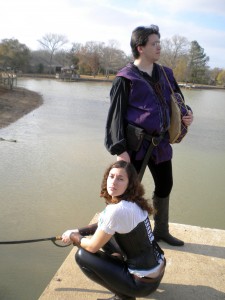
Learn More about Sassafrass and Sundown:

